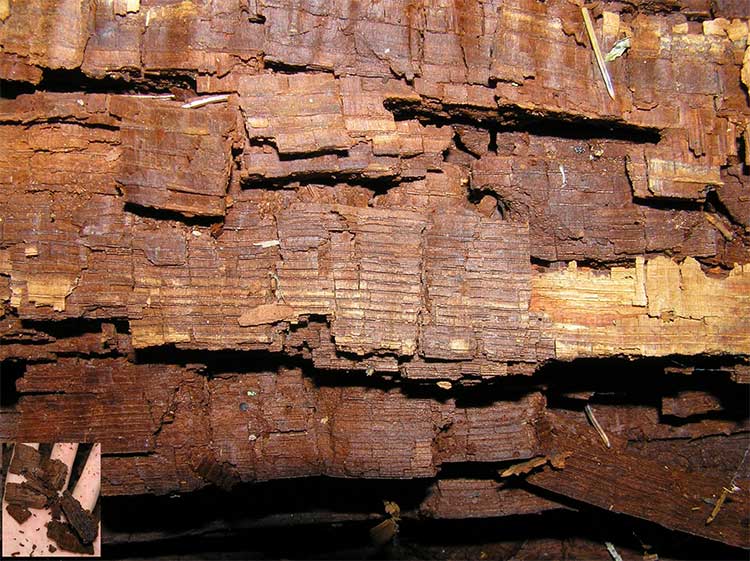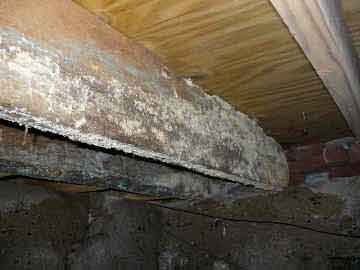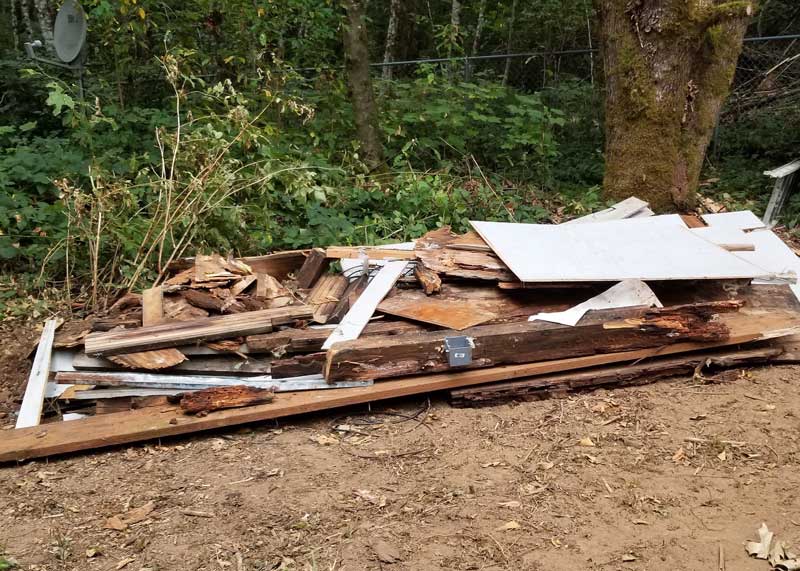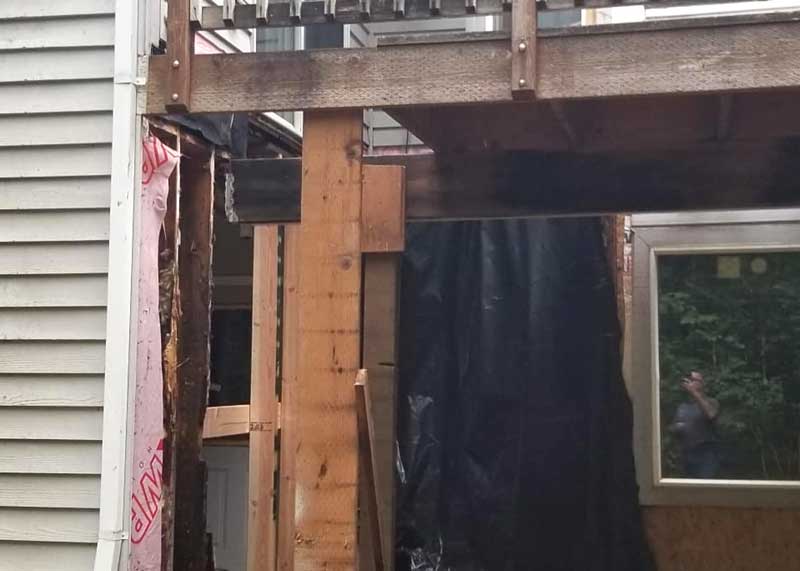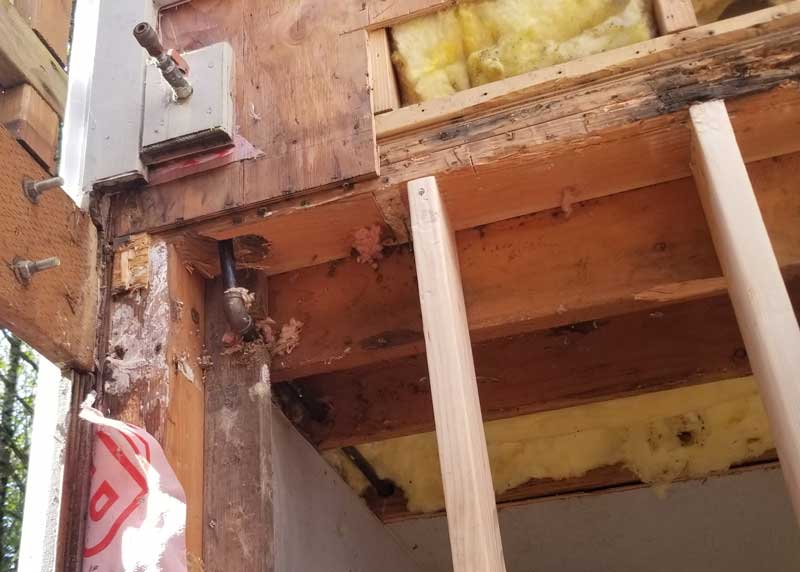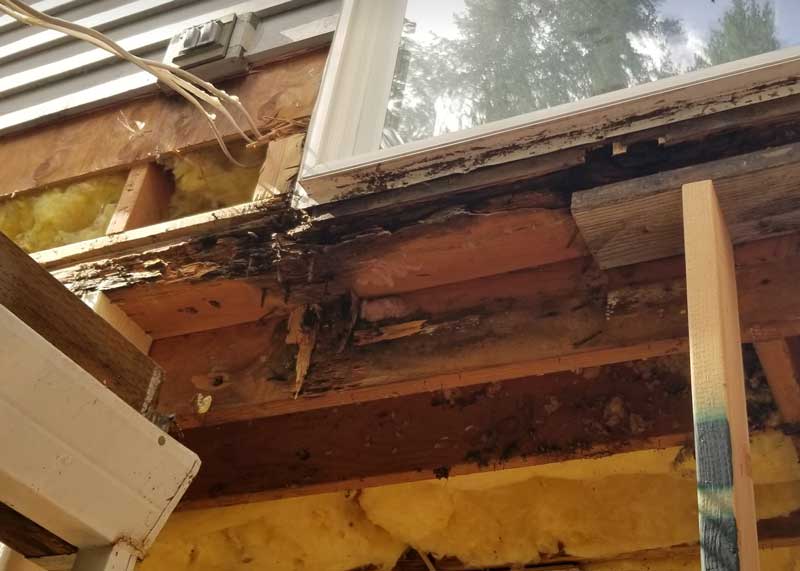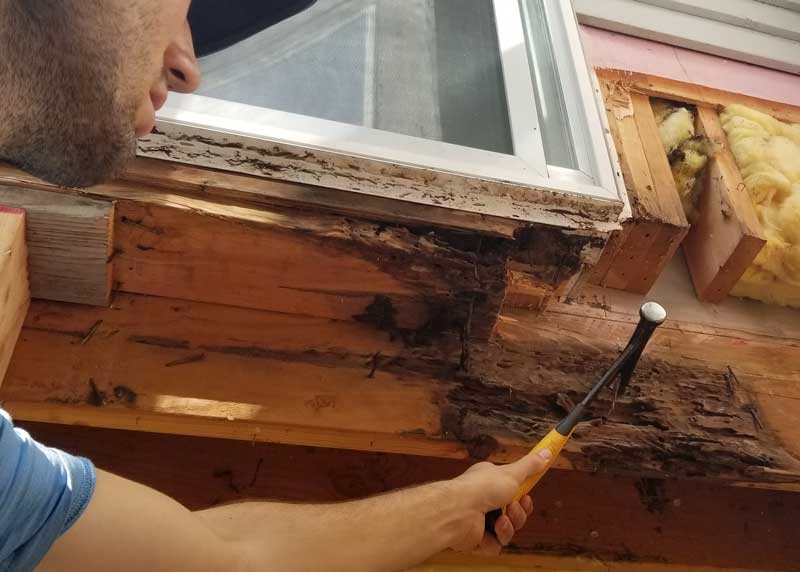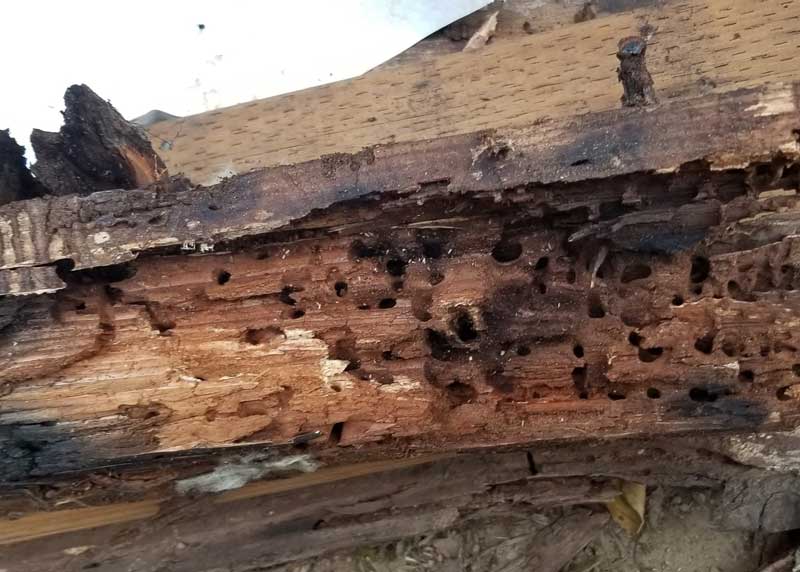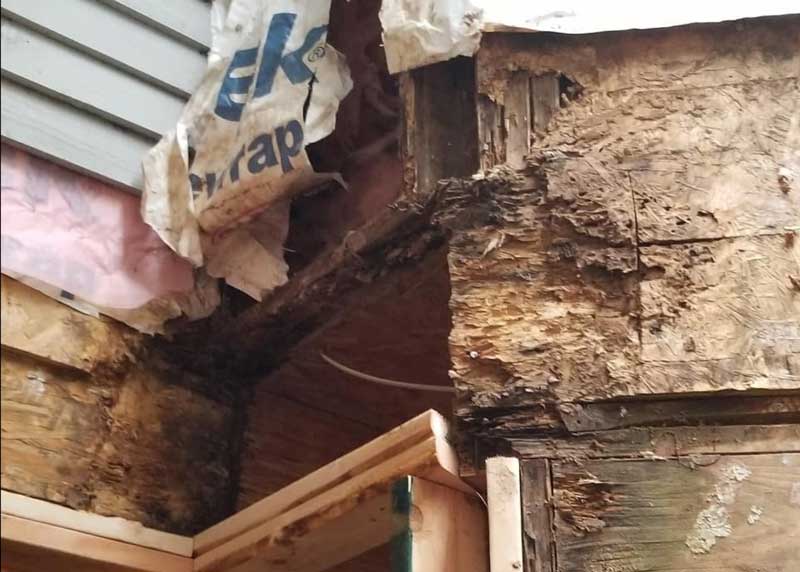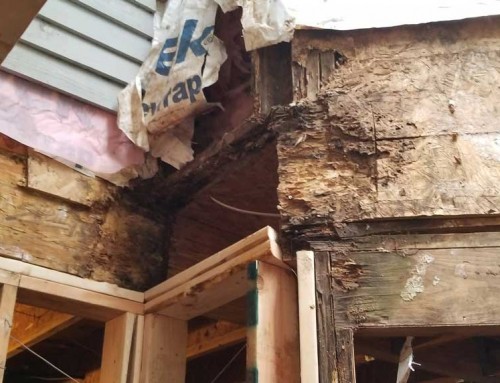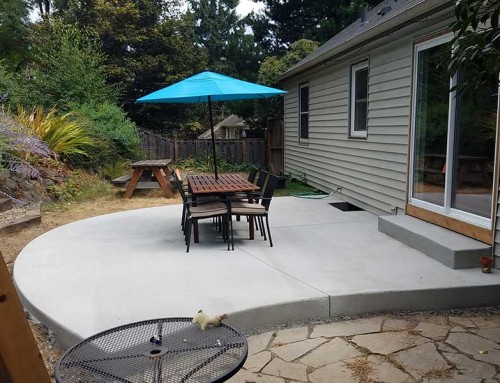Dry rot is the fungal decay of wood on the outside, and the inside, of your home. It’s especially common in our area, destroying valuable property and costing homeowners millions of dollars every year. It can affect roofs, decking, fences, and even the structural beams of your house. To create this damage, dry rot needs only three things: the fungal spores, moisture, and a food source, usually the wood portions of your house. The spores, the seeds of destruction, can be found everywhere in nature and even inside your home. The food, the wooden parts of your home, you probably want to keep in their current locations. That leaves moisture as the easiest thing to eliminate to control the spread of rot.
You probably haven’t done any exterior maintenance or repair in a while, and now you think you need a contractor to take care of some soft spots (dry rot, for sure) that you just noticed for the first time. They might be at the bottom of your T-111 siding. Maybe you saw discoloration and felt some soft wood in SPFcorner boards or window trim of your 3-year-old tract home. Wherever it is, it’s worrisome!
How do we assess dry rot damage?
Seeing clearly damaged wood on the surface is easy, but there can be more lurking underneath. The quickest and least expensive way for us to find dry rot is during the pressure washing before we repaint your home. We look for broken boards, broken caulk joints, and explore between butted siding joints, always listening for the telling “CRUNCH” of rotten wood under our knives.
Keeping the moisture on the correct side of the wall, the outside, is 90% related to the maintenance of caulking and paint, but there are a few other things to check. The lack of deck ledger flashing is a notorious cause of major dry rot repairs. Clean gutters and downspouts are the single biggest contributor to keeping the water away from your homes’ walls. Because of this, we suggest making sure that all are clean and functioning properly, even the rain drains. We also suggest that all landscaping be at least 12-18 inches away from your home to allow natural ventilation to help it dry out between the rains. Barkdust added every year might have come into contact with the lower part of your siding to begin the dry rot process. Most often, you will want to do these things yourself, but working together as a team is best. We are not really remedying the damage if all we do is remove the dry rot and allow the moisture problem to continue. Any one of these things can turn a minor annual caulking touch-up into a nasty, extensive, and expensive issue.
What Can You Do to Lower the Costs?
That is a great question! Your least expensive option is prevention. Clean your gutters fully at least once a year (more if you have a lot of trees dropping needles, pinecones, and leaves on your home). While you have your ladder out, you should look for signs of failed caulking, cut out any bad/cracked spots down to the back side of the siding, and replace those failed areas with new caulk.
If the damage is already done, you can lower the total cost of repairs by doing the damage discovery yourself. Remove the damaged wood and siding, trim back bushes and trees to allow for easy access, dispose of the debris, and clean the gutters and downspouts. You might even be able to fix the underlying cause (the moisture) of the dry rot. This will save the contractor time and effort, which will also save on the project’s cost.
Once you have completed the discovery and removed the damaged wood, invite multiple contractors over for estimates on putting it back together. It’s important for the contractor (hopefully, you’ll choose Capital Builders) to be able to open the siding and see compromised structural pieces. That way, I know what was there originally that needs to be replaced. This is critical when it comes to saving both time and money.
One of our last dry rot jobs was a pier and post addition on an older home. The homeowners had found what they called “a little dry rot.” They knew that they were many years past due on proper maintenance and hired us to discover the extent of the problem; they had located only a small area of soft wood. It wasn’t possible for them to know if the wall under the dry rot was also affected. It was! Because of that, we had to replace all the skirting and rebuild the lower part of the back porch, a job that took three weeks and cost thousands of dollars. Fortunately, though, the house was saved and will be good for another 50 years, provided regular maintenance is performed. A few more years of neglecting necessary maintenance, and the repairs to their home would have been considerably more extensive. This simple example should remind you to give your home a small amount of love annually before you need my, or a different contractor’s services.
What Goes Into an Estimate?
Imagine a car accident that results in a damaged bumper. You take your car to a body shop and receive a quote on the paint and new bumper and nothing else. The problem is that you may have serious axle or chassis damage, but that can’t be determined without a more thorough inspection. It’s the exact same thing with dry rot. Reputable companies will give you an estimate based on materials and an hourly rate per worker. Capital Builders operates the same way. There is really no way to offer a solid price without complete knowledge of what repairs are actually needed. If someone does offer you a total price for the job, our advice is to look for a different contractor.
Capital Builders gives you our best estimate of how many hours the dry rot repairs will take. Sometimes, the estimate is exactly correct, and sometimes we are under the amount quoted, which gives you a pleasant surprise, but sometimes, the opposite occurs. Pressure washing, which we employ as a tool for discovering additional damage, will often reveal more dry rot. Many other contractors rely on more expensive methods of finding dry rot that include the unnecessary labor of removing and replacing siding if no rot is uncovered,
You can read the review from a client named Mary Jane on our Testimonials page. Our original estimate came in much lower than the final cost because what appeared to be a ten foot section of one wall turned out to be the entire back of her house below the deck needing to be replaced. She had hired a retiree, someone she knew, for the repairs, but he was very quickly in over his head. Fortunately, she turned to us. How did this happen? There was no flashing when the deck was installed and little maintenance since. While she wasn’t happy about the major, unseen damage, and, therefore, the additional costs, every day when she came home from work, she could see the progress we made on the huge job. Essentially, Capital saved her home! She has been a repeat customer ever since and has booked two more jobs this year with us.
Another client is a mathematician. Prior to us starting, he was going to the nth degree to eliminate any uncertainty in the pricing for the dry rot. He wanted us to give him a price for replacing all of his siding, extending from one corner of his home to another. We did exactly what he needed, and the bill was pretty much as we had priced it initially, except that a set of steps needed to be removed and replaced to avoid other more costly work. Even though our contract was written to include variables, the mathematician subtracted one star from his otherwise positive review because he felt that we hadn’t communicated properly about the steps in advance. He was happy with the price, and our work, just not with the process. Despite the miscommunication on this job, we actually completed two more major projects for him over the next two years. Of course, we reviewed the concept of variables with him before starting those next two jobs
Another client who left an Angi’s List review for us with an even more positive experience. She highlighted our arriving, getting in, cleaning up, and leaving right on schedule. It really is sheer luck if the estimate ends up being right on the money because the extent of the damage all depends on where the water goes after it enters the house.
Hiring Capital Builders is spending your hard-earned dollars wisely. You can trust us to give you fair, honest pricing along with superior service.
A Capital Builders Extra
At the end of your job, we’ll ask if you might like to donate any leftover material to a charity like Habitat for Humanity. If you agree, we both will be helping those less fortunate. We also automatically offer a pay-it-forward option: we take smaller quantities of materials to our shop and offer it free to one of our next clients. And you could be the beneficiary of this option yourself!
Whether it is upgrading, working you into a tight schedule, insulating, or even doing a little landscaping in our efforts to find creative ways to go the extra mile, regardless of the size of the job, Capital Builders is there for each client.

